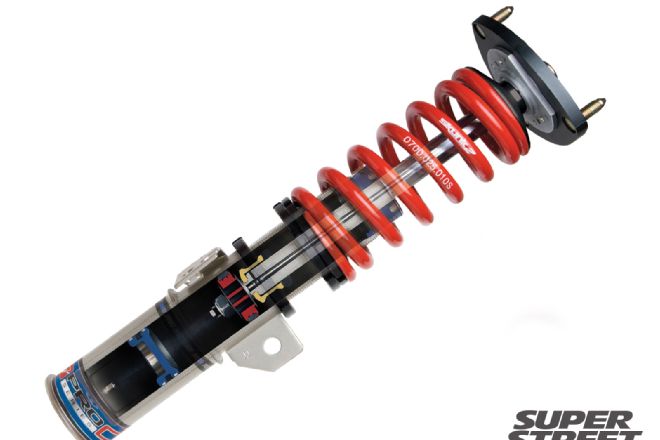Making your car handle better isn't easy. Camber, caster, toe, roll centers, motion ratios-suddenly building a show car sounds like a pretty good idea. Aside from tires, your coilover shocks are the single most critical component to your car not handling like a turd. But if selecting the right coilovers were easy, show cars would be in short supply. Besides the more conventional type of coilover shocks that are standard equipment on most cars, there are also high-performance versions, slip-fit coilovers and full-bodied coilovers. The choices don't end there, either: preload, material options, damping adjustability and the whole mono-tube versus twin-tube enigma is enough to make anyone care more about stuffed animals dangling from purple tow hooks than going fast.
More Than One Coilover Exists!
Not all coilovers are created equal. In fact, there are three kinds: OEM-style spring-over-shock assemblies, slip-fit coilovers and full-bodied coilovers. OEM-style spring-over-shock assemblies are based off of a conventional shock, or strut assembly, that's surrounded by its own coil spring. Such all-in-one coilovers are typically non-adjustable, feature fixed-length bodies and are precisely what you have no interest in reading about. Slip-fit coilovers are marginally more exciting and only slightly more complex. These consist of a hollow, threaded (usually aluminum) tube that slips over and sits on an existing shock's perch and, with the help of a series of jam nuts, compresses or decompresses its spring to alter ride height. There's virtually no performance gain to slip-fit coilovers, but they can be a quick and inexpensive way of dumping your car.
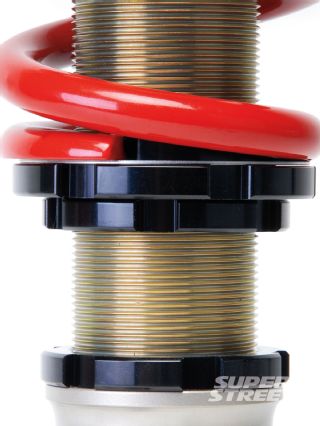 |
All adjustable coilovers feature a threaded body design that allows spring height and preload to be easily adjusted.
|
All adjustable coilovers feature a threaded body design that allows spring height and preload to be easily adjusted.
Full-bodied coilovers are what you've been thinking of since paragraph one. Full-bodied coilovers replace the entire factory spring and shock assembly and feature a threaded shock body for easy ride-height adjustments and, often times, adjustable damping. Similar to slip-fit coilovers, ride height adjustments are made through a series of jam nuts and by compressing or decompressing their springs. Higher-end coilovers also feature threaded lower bodies and lower mounts that can be screwed in and out for further ride height adjustments, essentially shortening the shock without altering spring compression. Another characteristic of higher-end, full-bodied coilovers is a shortened shock body, which allow for an even lower ride height without the risk of bottoming out.
Aside from the shock body, spring, jam nuts, and lower mount, the full-bodied coilover assembly may also include bump stops, dust boots and an upper mount assembly. Upper mount configurations vary depending on whether or not the suspension is based upon a double wishbone or MacPherson strut layout. Double wishbone layouts typically feature fixed upper mounts with rubber or polyurethane bushings while upper mounts designed for MacPherson setups typically include pillow-ball assemblies with camber and caster adjustability.
The Shock Body
At the heart of the full-bodied coilover is the shock. Like any shock, the coilover's upper mount connects directly to the chassis while its lower mount connects to its lower A-arm in double wishbone layouts or the knuckle itself in MacPherson strut configurations.
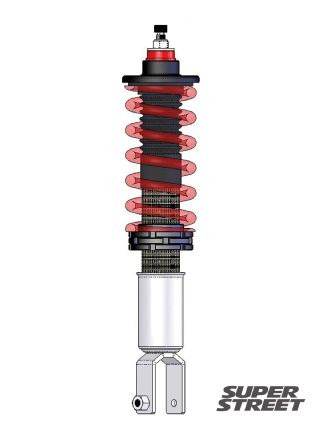 |
Full-bodied coilovers typically feature two-way height adjustment by means of spring compression and threaded lower bodies that result in a shorter or longer overall shock body.
|
Full-bodied coilovers typically feature two-way height adjustment by means of spring compression and threaded lower bodies that result in a shorter or longer overall shock body.
Shocks control unwanted spring oscillations and reduce vibrations caused by the wheels and chassis. When you hit a bump, the suspension's springs compress and decompress, absorb vibrations and transfer energy to the shocks through their upper mounts, into their pistons. As a result, the shocks dampen the vibrations, making that bump virtually unnoticeable. The degree to which all of this happens depends on the shock's internals: stiffer shocks slow spring movement while softer shocks do the opposite.
Shocks do more than just reduce vibrations and control spring movement, though; they also eliminate rocking, pitching, dipping, wheel spinning and all sorts of other things that aren't supposed to happen when turning or stepping on the gas or brake.
Inside the shock lies a hydraulic fluid-filled tube and piston. The piston pushes high-pressure fluid through the shock's valves, controlling how it responds against the spring. Kinetic energy harnessed through suspension movement turns into heat energy that ultimately dissipates within the shock's fluid. Valving is based upon small orifices perforated into the shock's piston that allow hydraulic fluid to bleed through as the piston travels up and down.
Mono-Tube vs Twin-Tube
Modern coilover shocks are offered in two configurations: mono-tube and twin-tube. Mono-tube shocks feature a piston and rod assembly housed within the damping case where both compression and rebound duties occur.
Twin-tube shocks feature two cylinders-the inner cylinder where the piston and shaft move up and down, and the outer cylinder, which serves as the hydraulic fluid reservoir. Twin-tube shocks allow for increased piston stroke, which can benefit ride quality and handling, but seldom overshadow the mono-tube design. Compared to twin-tube shocks, larger-diameter mono-tube shocks have the ability to displace more fluid, resulting in increased sensitivity to small suspension movements at low shaft speeds. The increased flow also allows for more consistent damping forces when compared to less expensive, twin-tube shocks. Most mono-tube shocks also run cooler than twin-tube designs because of their missing outer tubes.
 |
Full-bodied coilovers are made up of several components, including the shock body itself, the spring, a series of bushings,a bumpstop, upper and lower mounts, jam nuts, and various nuts, washers and collars that make everything work.
|
Full-bodied coilovers are made up of several components, including the shock body itself, the spring, a series of bushings,a bumpstop, upper and lower mounts, jam nuts, and various nuts, washers and collars that make everything work.
Shock Travel
When selecting coilovers, making sure you've got enough shock travel is key and will help prevent bottoming out. In case you didn't know: bottoming out is bad and defeats just about every single suspension modification you've made. The more travel, the better a shock can do its job. Spring choice also determines how much travel you'll need. Stiffer springs require less travel since the shock won't be able to compress as much.
Compression & Rebound
Full-bodied coilovers are available with three types of damping adjustability: manufacturer pre-set, single and double adjustable. Manufacturer pre-set coilovers are, not surprisingly, pre-set according to what the manufacturer thinks you need. Coilovers like these are typically valved for whatever springs they're paired with.
Before looking at coilovers with adjustable damping, it's important to understand what's being adjusted: compression and rebound. Compression occurs when the shock's piston moves into its body, compressing the hydraulic fluid in its chamber below. Rebound happens when it's pulled away, again compressing its hydraulic fluid. Generally speaking, compression controls the motion of the car's unsprung weight while rebound controls the motion of its sprung weight. In other words, compression controls how fast weight is applied toward the tire while rebound controls how fast weight moves away.
Shaft speed-the rate at which a shock's valves perform-is also important. Low and medium speeds typically influence handling while higher speeds contribute to better performance when traveling over bumps. A good shock is designed with various speeds and situations accounted for.
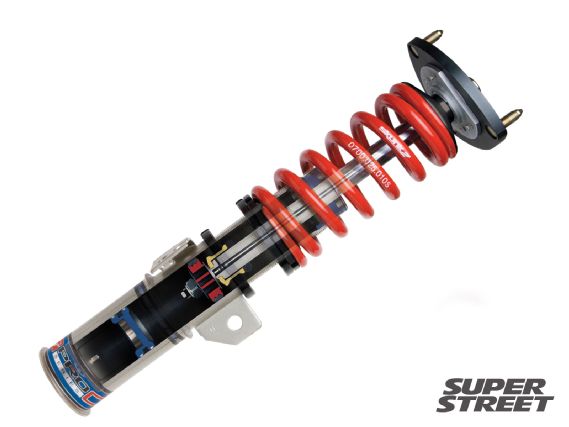 |
A shock's innter workings are fairly complicated and include a series of passages and valves that control compression and rebound. As the shock compresses and rebounds, hydraulic fluid is displaced, creating resistance and preventing the shock from bottoming out. This full-bodied mono-tube coilover features single-adjustable valving and two-way adjustable ride height by means of its spring perch and lower mount.
|
A shock's innter workings are fairly complicated and include a series of passages and valves that control compression and rebound. As the shock compresses and rebounds, hydraulic fluid is displaced, creating resistance and preventing the shock from bottoming out. This full-bodied mono-tube coilover features single-adjustable valving and two-way adjustable ride height by means of its spring perch and lower mount.
Single-adjustable damping controls both compression and rebound strokes together while higher-end, double-adjustable, or split level control, systems manage compression and rebound independently. Depending on the manufacturer, adjustments can range from eight all the way up to 32 different user-set positions. Single-adjustable damping typically affects low-speed rebound and only slightly affects compression, if at all. Still, these changes can improve cornering provided the rest of the suspension wasn't found on Craigslist. Adjustments are made with an externally mounted knob attached to a shaft that adjusts preload to a spring-loaded needle valve, which controls internal fluid flow. If you're looking for dramatic changes, be sure to explore proper tires, shock and spring rates, and anti-roll bar options first. Damping adjustments are typically best left for fine tuning and specific chassis balance.
The Spring
It's the springs that absorb bumps and control body roll, not the shocks. They do so by compressing and expanding to absorb individual wheel motion. It's the springs' job to prevent the chassis from bottoming out, control the tires when traveling over bumps, and manage body roll when cornering. They control squat while accelerating and reduce diving while braking. Springs also establish the car's ride height and center of gravity, which directly affects handling. Spring rates should be selected carefully. If they're too soft, the shocks will bottom out. If they're too stiff, any given tire's contact patch won't be fully utilized when cornering.
Preload
Preload is the amount of pressure applied to the springs based on how far they're compressed. Generally, a given amount is required to achieve specific operating characteristics. Adding preload can help mechanical grip by improving tire contact when turning, but excessive amounts will hurt performance. The problem with slip-fit coilovers and full-bodied coilovers that don't feature adjustable lower mounts is that ride height is adjusted dependent on preload. You can't change one without the other. If your car is mainly driven on the street or sees the occasional track day, then this is likely an acceptable tradeoff.
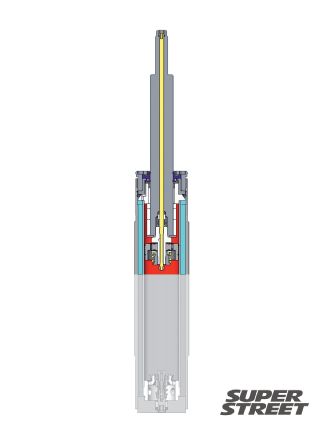 |
A shock's inner workings are fairly complicated and include a series of passages and valves that control compression and rebound. As the shock compresses and rebounds, hydraulic fluid is displaced, creating resistance and preventing the shock from bottoming out.
|
A shock's inner workings are fairly complicated and include a series of passages and valves that control compression and rebound. As the shock compresses and rebounds, hydraulic fluid is displaced, creating resistance and preventing the shock from bottoming out.
The Set Up
Installing and properly setting up full-bodied coilovers to best take advantage of their benefits requires a bit more foresight than a simple shock and spring installation. Before placing them on the vehicle, each spring should be slightly and equally preloaded-just enough to keep them from bouncing around within their assemblies. Next, thread the lower shock mounts onto their bodies in equal amounts. Refer to your installation instructions, but you'll typically want to make sure that the shock body threads into its lower mount at least one full inch. This is your maximum ride height. Install the coilovers, set the car on the ground, and assess its ride height. Reduce ride height as necessary using each shock's lower mount. Avoid pre-loading the springs further to achieve an even lower ride height unless the lower mounts have completely maxed out.
Coilovers might seem mysterious, but keep in mind that all shocks try to accomplish the same thing. The major differences can be found in their design, materials, wear, reliability and rebuilding potential. No matter how much adjustability a given coilover offers, if they weren't designed properly from the beginning, no amount of knob turning or spring compressing will help. In fact, a cruddy set of coilovers can bring out the worst in an otherwise good suspension. Unless you've studied suspension dynamics, you're better off choosing a brand you trust and hope somebody there does know a thing or two about all of this...and doesn't have a stuffed animal dangling from a purple tow hook.

